
Photos by Chris Mejia of Baja Test Kitchen
By Jennifer Kramer
Ask most people what they think of when asked to describe the landscape of the Baja peninsula and you’ll likely get an answer ranging from cactus-filled deserts to the turquoise waters of the Sea of Cortez. It’s only for a number of Baja travelers that pine trees and snow-capped mountains would make the list. If you’re one of the uninitiated with this unique landscape of the peninsula, consider taking a trip to the Sierra de San Pedro Mártir.
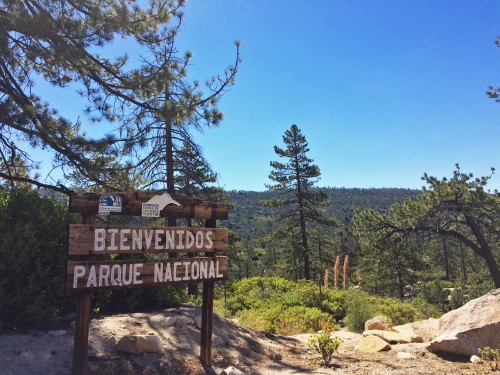 For nature lovers and adventure seekers, the Sierra de San Pedro Mártir is a playground in the summer when temperatures are pleasantly cool, unlike other parts of the peninsula. Located in the northern state of Baja California, access to the national park is from a turn off of highway Mexico 1 in San Telmo (between Colonet and Camalú). The San Pedro Mártir is an attractive mountain region for hiking and camping, and is home to the highest peak in Baja, Pichaco del Diablo at over 10,000 feet.
For nature lovers and adventure seekers, the Sierra de San Pedro Mártir is a playground in the summer when temperatures are pleasantly cool, unlike other parts of the peninsula. Located in the northern state of Baja California, access to the national park is from a turn off of highway Mexico 1 in San Telmo (between Colonet and Camalú). The San Pedro Mártir is an attractive mountain region for hiking and camping, and is home to the highest peak in Baja, Pichaco del Diablo at over 10,000 feet.
With the high elevation, the landscape here consists of pines, cypress trees, and snow-capped mountains in the winter. The diverse fauna include mule deer, bighorn sheep, cougar, bobcat, and coyote. The region also provides travelers with the rare opportunity to observe California condors in the wild, because of a successful reintroduction program that released the endangered birds into the area in 2002.
With clean air and low levels of light pollution, the national park is home to the National Astronomical Observatory with the second-largest telescope in all of Mexico. Outside of the national park in the lower-lying areas of the mountains, there are a few ranches that have opened their doors to accommodate travelers looking for a serene place to stay in the area.
Parque Nacional
 The 170,000-acre Parque Nacional Sierra de San Pedro Mártir (tel. 011-52-646-172-3000, sanpedromartir@baja.gob.mx) is home to the highest peak in Baja, Pichaco del Diablo, (Devil’s Peak) at 10,154 feet. The park is full of pine and fir trees, snow-capped peaks, and 142 plant species, making this one of the most prestigious natural protected areas in all of Mexico.
The 170,000-acre Parque Nacional Sierra de San Pedro Mártir (tel. 011-52-646-172-3000, sanpedromartir@baja.gob.mx) is home to the highest peak in Baja, Pichaco del Diablo, (Devil’s Peak) at 10,154 feet. The park is full of pine and fir trees, snow-capped peaks, and 142 plant species, making this one of the most prestigious natural protected areas in all of Mexico.
The park entrance is at Km. 84 on the paved road from San Telmo. All people entering the park must stop at the park entrance to go into the ranger station (open 7am-8pm daily) to register and pay the park entrance fee to get a wristband. The entrance fee is 64 pesos per person per day. Camping fees are included in that price.
There’s a Cultural Center in the park that’s open Fri.-Sun. 10am-3pm. The small but nice museum features information about the history and science of the area, and information about the Kiliwa people, who were native to the region. Signs and information are in Spanish.
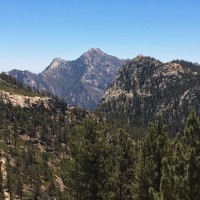 Hiking
Hiking
There are a number of marked trails throughout the park that are well maintained. Several depart from the camping area and from park roads. Hiking off-trail is also permitted in the park, but make sure to have GPS and topography maps. There are a number of beautiful ridges and vistas to enjoy throughout the park. Take enough water and be aware of the high altitude. One popular route is the six-mile round-trip hike to El Altar. The trek features views of Picacho del Diablo, the desert of San Felipe, the Sea of Cortez, and even the coast of Sonora on a clear day.
Experienced backpackers may want to summit Picacho del Diablo. The mountain is normally approached from the eastern side on a multi-day trip. For an experienced guide, contact Sophia Bautista at 011-52-664-272-5312.
Observatorio Astronómico Nacional
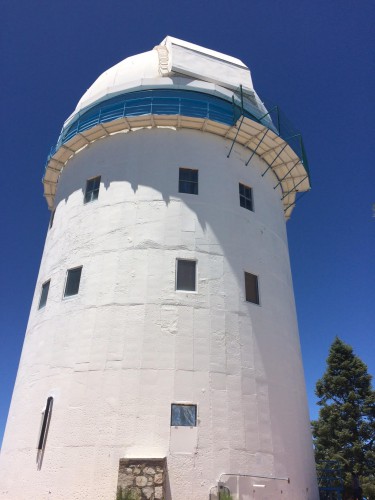 Located inside the national park at Km. 100 at the end of the paved road is the Observatorio Astronómico Nacional (tel. 011-52-646-174-4580, www.astrossp.unam.mx, jefatura@astrosen.unam.mx, 10am-1pm and 2pm-3pm Mon.-Fri.). The observatory is home to the second-largest telescope in Latin America. With clean air and very little light pollution, the San Pedro Mártir provides ideal atmospheric conditions for astronomy and the observatory is regarded as one of the best places on earth to observe the planets and stars.
Located inside the national park at Km. 100 at the end of the paved road is the Observatorio Astronómico Nacional (tel. 011-52-646-174-4580, www.astrossp.unam.mx, jefatura@astrosen.unam.mx, 10am-1pm and 2pm-3pm Mon.-Fri.). The observatory is home to the second-largest telescope in Latin America. With clean air and very little light pollution, the San Pedro Mártir provides ideal atmospheric conditions for astronomy and the observatory is regarded as one of the best places on earth to observe the planets and stars.
There are actually three high-powered, deep-space telescopes at the observatory. The first was introduced in 1974, the second in 1975, and the last (and largest, with a 2.12 meter optical) in 1979. The U.S., China, and Mexico are currently working together to add three more telescopes that will be controlled remotely digitally.
To take a free tour of the observatory and the largest telescope, you can inquire at the gate of the observatory during visiting hours. You’ll need to use the intercom at the gate to let them know you’d like to visit the observatory. Because this is a working observatory, you may need to wait for a while before they will come down to let you through the gate and accompany you by car up to the observatory.
Once up at the observatory, they may or may not be able to allow you in to see the telescope, depending on what they are working on that day. Either way, don’t miss the sweeping views you get from walking around behind the observatory. From here, you’ll be able to see Picacho del Diablo, the Sea of Cortez to the east, and the Pacific to the west.
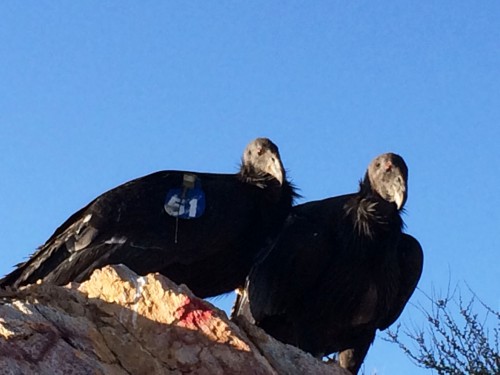 California Condors
California Condors
In August 2002, five condors were transferred to Sierra San Pedro Mártir as a program to reintroduce the species to the wild. The San Diego Zoo manages the recovery program, working with Mexico’s National Commission for Natural Protected Areas and the U.S. Fish and Wildlife Service. As of 2015, there were 28 condors living in the San Pedro Mártir and 410 worldwide.
It’s possible to see condors throughout the park, so keep an eye out. Just before the entrance to the National Park is a lookout where California condors congregate. You’ll find some of the endangered birds perched on top of granite rocks and can watch as they soar over the valley. This is a unique chance to see the birds in their natural habitat. The condors living in the San Pedro Mártir have become used to humans and are therefore easy to observe and photograph.
Accommodations:
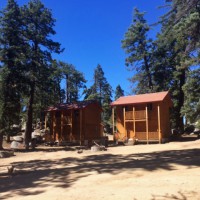 For those who want to stay right in or near the national park, tent camping or the cabins at the park entrance are the only option. Camping is included in your park entrance fee. There are a number of campsites throughout the park where overnight camping and campfires are permitted. There are fire pits and porter potties, but not much else in terms of services. There are also day sites where campfires are not allowed.
For those who want to stay right in or near the national park, tent camping or the cabins at the park entrance are the only option. Camping is included in your park entrance fee. There are a number of campsites throughout the park where overnight camping and campfires are permitted. There are fire pits and porter potties, but not much else in terms of services. There are also day sites where campfires are not allowed.
At the park entrance near the ranger station are four cabins that are run by the national park. The two larger two-story cabins ($1,700 pesos a night) sleep eight people, and the two smaller cabins ($700 pesos a night) sleep four people. There are bunk beds (visitors need to bring their own sheets or sleeping bags), running water in the bathrooms, 24/7 electricity, and a stove (you’ll need to bring your own propane), but no refrigeration. Grills and fire pits are available outside the cabins and they provide you with a portion of wood for your stay. You have to reserve the cabins in advance by calling the following number between 8am-3pm: 011-52-646-172-3000 ext 3229.
For a stay in the foothills of the San Pedro Mártir, Baja Dark Skies and Rancho Meling (along with their sister property Rancho El Coyote) provide peace and tranquility, along with easy access to the national park.
DBTC Insider Tips:
-The road for the national park turns off from Mexico 1 at San Telmo and is one road that is paved all the way to the National Observatory at Km. 100. The National Park entrance is at Km. 84. Turn offs for Rancho Meling (Km. 50) and Baja Dark Skies (Km. 67) are along the way before reaching the park entrance. It takes about two hours to reach the observatory from Mexico 1.
-There is no where to get gas, water, food, or any other provisions once you make the turn off from Mexico 1. Fuel up and buy any provisions in San Telmo before heading to the Sierra de San Pedro Mártir. Rancho Meling is the only place in the area to get a meal, but arrangements must be made with them in advance.
-You should make a reservation in advance to stay at the cabins at the national park or at any of the surrounding ranches in this area. There’s no cell service or wifi service in this area.
-Because of the elevation, this area stays refreshingly cool in the summer and can get very cold in the winters (average temperature below freezing) with a decent amount of snow. Even in summers, temperatures can dip below freezing at night, so be prepared if camping.


I have a vacation home in Las Villas, El Dorado Ranch, so San Pedro Martir is a definite visit on my next trip. I did not know there was so much to see, especially Pine trees, canyons, wild animals, snow and even an observatory.
El Alton is a remarkable viewpoint and where we spread the ashes of my father, Norman C. Roberts in 2009 as his last request. Norman was the author of “Common and interesting Plants of Baja California”.
hi,
would be possible to sleep in san telmo, go to the trailhead for el altar, do the 6 miles round trip and go back in the same day to san telmo? i’m planing it in february and sleeping with a tent would be impossible for me.
That would put you driving in the dark both directions from the park to San Telmo, which is not recommended. Plus, there are not options for accommodations in San Telmo. Your best non-tent camping option would be to stay at the cabins that are located at the entrance to the national park.
Hello, I want to go several days in this month of November and I heard it is very cold so I have been looking for accommodations there is no space in for cabins in the San Pedro’s park, or rancho Meling or Coyote, do you know some other place to stay near the park? where I can look for to stay? I will really appreciated.
Hi there, the only other place to stay near the park is Baja Dark Skies – https://bajadarkaskies.wordpress.com
Are dogs allowed?
Gracias
Yes, dogs are allowed
Hi there! Will be visiting this area next month. We are touring the Baja and we’ll have our dog with us. Are dogs allowed in this National Park? On the trails?
Dogs are allowed in the park! You should call the park directly ahead of time to ask about the specifics – 011-52-646-172-3000
Park reception area in Sierra de San Pedro Martir National Park, one of the few structures in the 170,000-acre wilderness Dave Deroulhac
Where can I find topographic maps of the park for backpacking? Any advice would be appreciated.
Mexico Maps has good detailed topographic maps for all of Baja, including the San Pedro Mártir. Their list of topo maps for that region can be found here: https://www.mexicomaps.com/mexico_topographic_maps.lasso